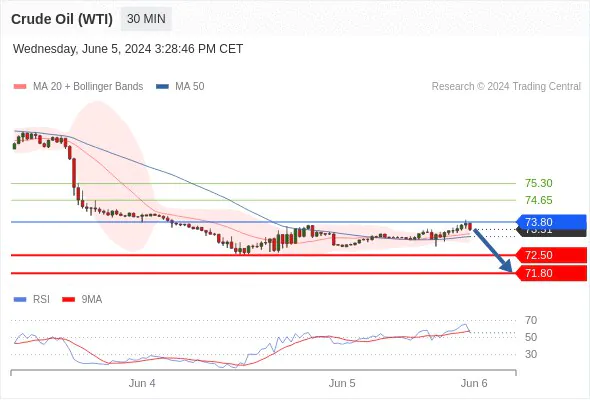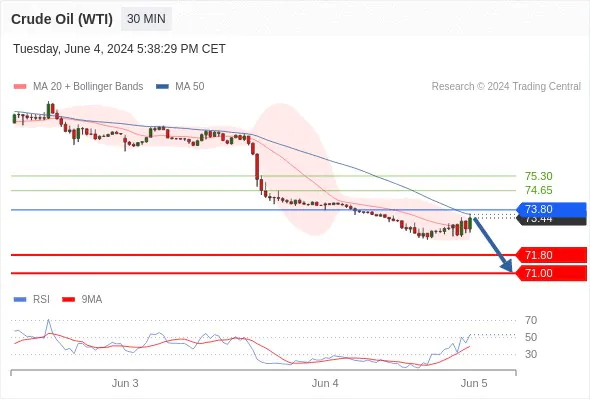Crude oil, particularly West Texas Intermediate (WTI), is one of the most actively traded commodities in the world. Its price movements are closely watched by traders, investors, and analysts due to its significant impact on the global economy. Predicting the price of WTI crude oil involves analyzing a combination of technical indicators, market trends, geopolitical events, and economic data. This comprehensive analysis provides insights into the current price prediction for WTI crude oil, including key levels of support and resistance, preferred trading strategies, and potential scenarios.
Introduction to Crude Oil (WTI) Trading
West Texas Intermediate (WTI) is a grade of crude oil used as a benchmark in oil pricing. It is known for its high quality and is lighter and sweeter compared to other crude oils. WTI is predominantly produced in Texas and is a primary benchmark for oil prices in the United States.
Traders and investors engage in WTI crude oil trading to profit from price movements driven by various factors, including supply and demand dynamics, geopolitical tensions, and economic indicators. Understanding these factors and their impact on prices is crucial for making informed trading decisions.
Key Factors Influencing Crude Oil (WTI) Prices
1. Supply and Demand Dynamics
The basic principle of supply and demand significantly influences WTI crude oil prices. When supply exceeds demand, prices tend to fall, and when demand surpasses supply, prices rise. Factors such as OPEC production levels, U.S. shale oil production, and global economic growth impact supply and demand dynamics.
2. Geopolitical Events
Geopolitical tensions, conflicts, and instability in oil-producing regions can lead to supply disruptions, causing price volatility. For instance, conflicts in the Middle East or sanctions on major oil producers can reduce supply and push prices higher.
3. Economic Indicators
Economic indicators such as GDP growth, industrial production, and employment rates influence oil demand. A strong economy typically boosts oil demand, leading to higher prices, while a weak economy reduces demand, causing prices to fall.
4. Technological Advancements
Advancements in extraction and production technologies, such as hydraulic fracturing (fracking), have increased the supply of oil, particularly in the United States. These technological advancements can lead to lower production costs and increased supply, impacting prices.
5. Market Sentiment
Market sentiment and speculative activities play a significant role in short-term price movements. Traders’ perceptions of future supply and demand conditions, influenced by news, reports, and forecasts, can drive price fluctuations.
Technical Analysis of Crude Oil (WTI)
Technical analysis involves studying price charts and using technical indicators to predict future price movements. Key levels of support and resistance, trend lines, and chart patterns are essential tools for technical analysts.
Crude Oil (WTI) (N4) Intraday: Key Resistance at 73.80
Pivot: 73.80
Our Preference:
- Short positions below 73.80 with targets at 71.80 & 71.00 in extension.
Alternative Scenario:
- Above 73.80, look for further upside with 74.65 & 75.30 as targets.
Comment:
The upward potential is likely to be limited by the resistance at 73.80.
Supports and Resistances:
| Level | Type |
|---|---|
| 75.30 | Resistance |
| 74.65 | Resistance |
| 73.80 | Resistance |
| 73.44 | Last Price |
| 71.80 | Support |
| 71.00 | Support |
| 70.60 | Support |

Trading Strategies for Crude Oil (WTI)
1. Breakout Trading
Breakout trading involves entering a position when the price breaks through a key level of support or resistance. For WTI crude oil, traders can look for breakouts above resistance levels or below support levels to capitalize on significant price movements.
Example Strategy:
- Entry Point: Short position below 73.80
- Targets: 71.80 & 71.00
- Stop Loss: Above 73.80 to limit potential losses
2. Trend Following
Trend following is a strategy where traders aim to profit from sustained price movements in a particular direction. By identifying and following trends, traders can ride the momentum and maximize their gains.
Example Strategy:
- Identifying Trends: Use moving averages or trend lines to identify upward or downward trends
- Entry Point: Enter positions in the direction of the trend
- Exit Point: Close positions when the trend shows signs of reversal
3. Range Trading
Range trading involves identifying price ranges where the asset trades between support and resistance levels. Traders buy at support and sell at resistance, profiting from the predictable price oscillations.
Example Strategy:
- Entry Point: Buy at support levels (e.g., 71.80)
- Targets: Sell at resistance levels (e.g., 73.80)
- Stop Loss: Below the support level to manage risk
Risk Management in Crude Oil (WTI) Trading
Effective risk management is crucial for successful trading. It involves setting stop-loss orders, managing position sizes, and diversifying trading strategies to minimize potential losses.
1. Setting Stop-Loss Orders
Stop-loss orders automatically close a position when the price reaches a predetermined level, limiting potential losses. Traders should set stop-loss levels based on their risk tolerance and market volatility.
2. Managing Position Sizes
Position sizing involves determining the appropriate amount of capital to allocate to each trade. Traders should avoid risking too much capital on a single trade and instead diversify their positions to spread risk.
3. Diversifying Trading Strategies
Using a combination of different trading strategies can help mitigate risks. For example, combining breakout trading with trend following and range trading can provide opportunities in various market conditions.
Conclusion
Predicting the price of WTI crude oil requires a comprehensive analysis of technical indicators, market trends, and external factors such as geopolitical events and economic data. By understanding key levels of support and resistance, traders can make informed decisions on when to buy and sell WTI crude oil.
Today’s analysis indicates that WTI crude oil faces key resistance at 73.80. Traders should consider short positions below this level, targeting 71.80 and 71.00. Alternatively, if the price breaks above 73.80, further upside targets include 74.65 and 75.30. As always, effective risk management and a well-rounded trading strategy are essential for navigating the volatile oil markets.
For more detailed analysis and updated forecasts, stay tuned to financial news and market reports. Happy trading!
Disclaimer: Trading commodities involves significant risk and may not be suitable for all investors. Ensure you understand the risks and seek independent advice if necessary.


That’s fantastic to hear! Your feedback is greatly appreciated. I’m thrilled that you’re finding value in the free robot forex and seeing such great results. Thank you for your support and for sharing your success!.